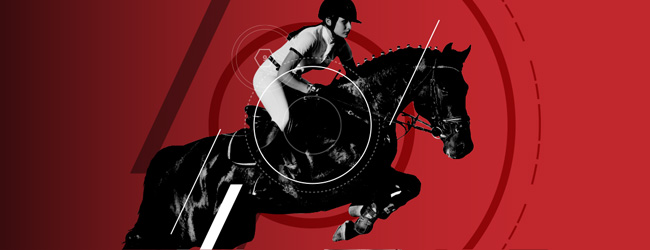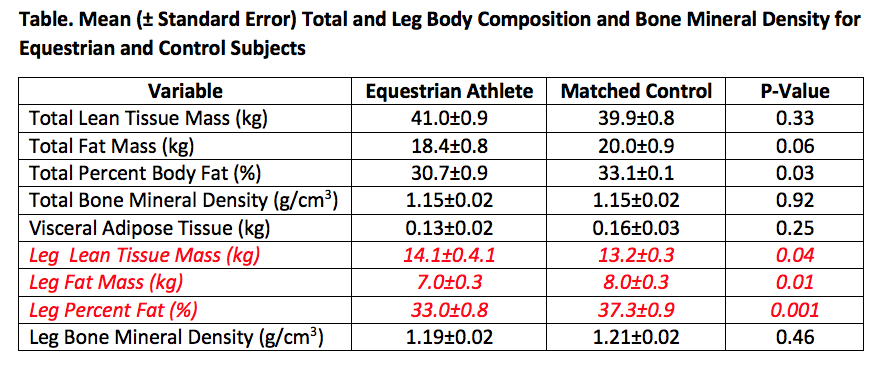Using DXA in Equestrian Athletes
We recently published a paper in the International Journal of Sports Medicine (Dengel et al., 2019) that examined body composition in collegiate equestrian athletes. You may ask why an equestrian athlete or coach would be interested in body composition. Equestrian athletes are judged to some degree on their posture while riding the horse. For that reason alone, body composition plays a role in the sport. In addition, special attention was paid to the bone mineral density of college equestrian athletes. These athletes typically ride three to four times a week for several hours at a time (Brunton, 2013). This is a significant amount of time involved in a non-weight bearing activity. Previous studies regarding other non-weight bearing sports (i.e., cycling, swimming, etc.) have found that bone mineral density was lower in these athletes than their high impact counter-parts (Lukaski, 2017). However, it should be noted that the motion of the horse as it maneuvers obstacles and jumps over barriers may provide these athletes with enough bone stress to offset the non-weight bearing aspect of the sport. It is unclear whether these athletes would suffer from a lower bone mass density in comparison to the non-athletic portion of the population. Therefore, we decided to examine the effect of equitation on bone health in female collegiate equestrian athletes.
What is actually involved in collegiate equestrian competitions?
For those of you unfamiliar with the sport, collegiate equestrian athletes compete in two types of horsemanship: western style and hunt seat. Western-style horsemanship is judged on a rider being able to maneuver the horse through seven to nine maneuver patterns while maintaining correct body position. Hunt seat horsemanship differs from western style horsemanship in that the saddle used is more confined, and there are different types of events in the competition. One event has the rider perform a pattern of nine maneuvers consisting of trotting, halting, backing up, etc. on flat terrain (NCEA, 2017). The second style of hunt seat competition involves the rider performing a series of eight to ten jumps over barriers (NCEA, 2017).

Design of the study
For this study, 31 female collegiate equestrian athletes were matched to a population of normal, non-athlete college students by age (19.8±0.2 vs. 19.8±0.2 yrs.), body mass index (22.3±0.4 vs. 22.6±0.4 kg/m2), sex and ethnicity. Total and regional fat tissue mass, lean tissue mass, bone mineral density and abdominal visceral adipose tissue (VAT) were measured by dual X-ray absorptiometry (DXA).
Results of the study (Table)
The results for this study can be found in the table below. We found that even though the athletes were matched on body mass index, equestrian athletes had a lower total fat percentage (%fat) than controls. In addition, there was a trend for the equestrian athletes to have lower total fat mass than controls. However, there were no significant differences in total lean tissue mass, total bone mineral density and abdominal visceral adiposity tissue between equestrian athletes and controls. What was interesting was that equestrian athletes, when compared to the controls, had significantly lower leg %fat, leg fat mass and higher leg lean tissue mass (highlighted in red in the table). There was no difference in leg bone mineral density between equestrian athletes and controls.

What does it all mean?
So what does all of this mean? Well, the lower total percent body fat in equestrian athletes seems to be influenced by differences in leg composition with equestrian athletes having significantly more lean tissue mass and less fat mass. These results are consistent with the role the legs play in horseback riding and demonstrate an effect of either training or horseback riding on body composition compared to matched controls. In addition, even though equestrian athletes spend a lot of time doing non-weight bearing activities, it does not appear to negatively affect their bone mineral density.
References
Brunton, M. Equestrian Team Balances Athletic, Academic Responsibilities. TCU 360, TCU 360, 28 Mar. 2013, www.tcu360.com/story/17614equestrian-team-balances-athletic-responsibilities-education.
Dengel OH, Raymond-Pope CJ, Oliver JM, Bosch TA, Dengel DR: Body composition and visceral adipose tissue in female collegiate equestrian athletes. International Journal of Sports Medicine 40(6):404-408, 2019.
Lukaski, HC. Body Composition in Perspective. In: Lukaski HC. Body Composition: Health and Performance in Exercise and Sport. Boca Raton, FL: CRC Press; 3-11, 2017
National Collegiate Equestrian Association. Competition Format.CollegiateEquestrian.com - The Official Site of the NCEA, National Collegiate Equestrian Association, 2017. www.collegiateequestrian.com/home/main.
About the Authors
Donald Dengel, Ph.D., is a Professor in the School of Kinesiology at the University of Minnesota and is a co-founder of Dexalytics. He serves as the Director of the Laboratory of Integrative Human Physiology, which provides clinical vascular, metabolic, exercise and body composition testing for researchers across the University of Minnesota.
Olivia Dengel, B.S., is a veterinary student at the University of Minnesota.